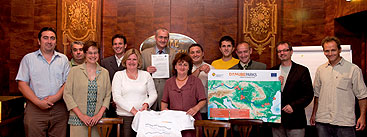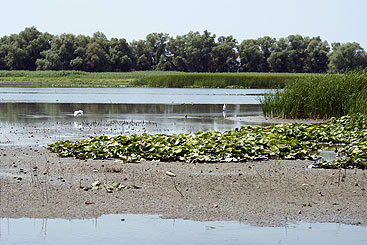
Protecting the joint heritage of Europe
A new network of national parks, biosphere reserves, special protected areas, special zoological reserves and protected landscape areas is providing a new quality in conservation through international cooperation.

Protected Areas, such as the Nature Reserve Gornje Podunavlje, act as stepping stones in the network of habitats and, therefore, play an important role in the implementation of NATURA 2000.
The enlargement of the European Union has created a new framework for political and societal cooperation along the Danube. The dynamic economic development and the subsequent massive increase in traffic along the Danube corridor are exerting pressure on the last remaining natural wetlands and river stretches. At the same time, EU directives like NATURA 2000 and Water Framework Directive provide common regulative policies for enhanced nature conservation at a transnational level. The preservation of our shared natural heritage on the Danube is a common european task, now more than ever.
Building on already existing bilateral cooperation, eight individual Danube Protected Areas signed a declaration in 2007 which aimed to create a network of protected areas (see Danube Watch 2/2007). This led to the joint elaboration and submission of the project DANUBEPARKS within the framework of the EU South East Europe Transnational Cooperation Programme. From a total of 821 applications, DANUBEPARKS was one of only 40 projects which were selected and approved. With a budget of 2.7M and duration of three years, DANUBEPARKS should erect structures for a sustained and intense collaboration within the framework of the Danube River Network of Protected Areas, and concrete transnational projects should begin to be implemented. On 9 June 2009, DANUBEPARKS was officially christened with the signing of the “Declaration of Vienna”.
“Because the Danube is a cohesive ecosystem it is especially important to work together on a transnational basis on all matters having to do with habitat management and conservation,” says Carl Manzano, Donau-Auen National Park Director. “In fact, this is the only way to protect and sustain our shared natural heritage.”
A partnership for conservation. With the Donau-Auen National Park acting as lead partner, a total of 12 Protection Areas and National Parks in Austria, Bulgaria, Croatia, Germany, Hungary, Romania, Serbia and Slovakia are participating as project partners in the implementation of the DANUBEPARKS project.
The DANUBEPARKS project includes seven concrete work packages: development and management of the network; floodplain management; river morphology and revitalisation; conservation of species; monitoring and NATURA 2000; nature tourism and communications, marketing and public relations.
DANUBEPARKS is a permanent platform for knowhow and experience transfer among the Danube Protected Areas. It will assist in the development and formulation of shared transnational strategies and concepts and in the implementation of cross-border and transnational revitalisation and conservation projects.

The DANUBEPARKS programme will assist in the development and formulation of shared transnational strategies and concepts and in the implementation of cross-border and transnational revitalisation and conservation projects.
Conservation of species. Existing nature reserves today already play a vital role in conservation on the Danube. Yet animals and plants do not obey national boundaries when seeking out suitable habitats. This is why cross-border species conservation projects are a top DANUBEPARKS priority.
The Danube sturgeons and the White-tailed Eagle are symbols of the urgent need for transnational species protection programmes in the Danube region. For successful spawning, the migratory sturgeon requires a barrier-free river flow upstream from the Black Sea to Vienna. Due to the construction of power plants on the middle reach of the Danube, the continuous flow so vital to the migratory sturgeon has been interrupted.
“Local conservation measures alone are not enough for the maintenance of biodiversity in the Danube region,” says Grigore Baboianu, Governor of the Danube Delta Biosphere Reserve in Romania. “What is really necessary for the protection of endangered species are internationally-coordinated conservation endeavours and cross-border efforts. DANUBEPARKS will be able to make a significant contribution.”
Thanks to its expansive range, the presence of the majestic White-tailed Eagle, the largest bird of prey on the Danube, is a sign of connected and contiguous riverine habitats. The implementation of a transnational conservation strategy is required to develop the Danube as a central habitat for the White-tailed Eagle in South East and Central Europe.

The Danube River is home to a rich biodiversity, with protected areas playing an essential role in the protection of that biodiversity. But for many species even large protected areas are not big enough for their protection, especially for organisms with large territories and migratory species, hence the need for transnational conservation measures.
Speaking with one voice on important issues. An additional priority for project partners is the development of nature tourism in the Protected Areas. The creation and realisation of joint visitor concepts and programmes within the framework of DANUBEPARKS should help to strengthen each individual area administration and serve to anchor the protected area more firmly in its own region.
“Especially important is the exchange of ideas and experiences among the Protected Areas,” says Eszter Buchert, Deputy Director of the Duna-Drava National Park. “We all are facing similar problems and can thus learn from each other. I am particularly excited about developing and implementing joint activities and ideas for nature tourism.”
At the same time, collaboration at a transnational level should expand the horizons of each individual protected area regarding management tasks and cement their role in conservation tasks at a national level. DANUBEPARKS should enable the Danube Network Protected Areas to speak with one voice on behalf of the shared natural heritage of the Danube.
DeClaRatIon oF vIenna
The substantial preparatory work of recent years was rewarded in June 2009 with the foundation of DANUBEPARKS through the signing of the ‘Declaration of Vienna’. The Danube River Network of Protected Areas will guarantee an ongoing collaboration among Protected Areas along the Danube as well as the realisation of transnational projects addressing diverse conservation issues. A budget of € 2.7M will support this pilot project over the next three years.
For more information, please visit: www.danubeparks.org.
Disclaimer
The information contained in the ICPDR website is intended to enhance public access to information about the ICPDR and the Danube River. The information is correct to the best of the knowledge of the ICPDR Secretariat. If errors are brought to our attention we will try to correct them.
The ICPDR, expert group members, nor other parties involved in preparation of information contained on this website cannot, however, be held responsible for the correctness and validity of the data and information provided, nor accept responsibility or liability for damages or losses arising directly or indirectly from the use of the information conveyed therein.
Only those documents clearly marked ICPDR documents reflect the position of the ICPDR.
Any links to other websites are provided for your convenience only. The ICPDR does not accept any responsibility for the accuracy, availability, or appropriateness to the user's purposes, of any information or services on any other website.
When using the information and material provided on this website, credit should be given to the ICPDR.
